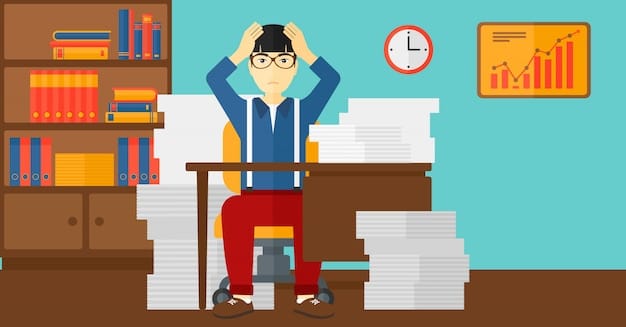Stop Procrastinating: 5 Strategies for Peak Productivity

Stop procrastinating today by mastering five tested strategies to boost your productivity and achieve your goals faster, turning overwhelming tasks into manageable steps and unlocking your full potential.
Are you tired of putting things off and watching your goals slip away? Learn how to stop procrastinating: 5 strategies to boost your productivity and achieve your goals faster are discussed below.
Understanding Procrastination: Why We Do It
Procrastination is a common struggle, but understanding why it happens is the first step to overcoming it. It’s not just about laziness; it’s often rooted in deeper psychological factors.
Many people procrastinate because they fear failure or perfectionism. The pressure to perform perfectly can be paralyzing, whereas, understanding the root cause can help you address the issue effectively.
The Fear of Failure
The fear of not meeting expectations can lead to avoidance. Many people delay starting tasks because they don’t want to confront their own perceived inadequacies.
Perfectionism and Procrastination
Perfectionists often set unrealistic standards for themselves. This can cause them to procrastinate because they are afraid of not meeting those standards.
Lack of Motivation
Finding it difficult to get started on tasks that seem boring or uninteresting is also a big factor. This lack of intrinsic motivation makes it easier to put things off.
- Break tasks into smaller, manageable steps to make them less daunting.
- Set realistic expectations for yourself and avoid striving for unattainable perfection.
- Find ways to make the task more enjoyable or rewarding to increase motivation.
Procrastination is often a response to feeling overwhelmed or stressed. By addressing the underlying reasons, such as fear or lack of motivation, individuals can develop healthier strategies for managing their time and tasks. Recognizing these triggers is crucial for developing effective strategies to beat procrastination. As you begin to understand yourself, you can learn how to stop procrastinating: 5 strategies to boost your productivity and achieve your goals faster.
Strategy 1: The Pomodoro Technique
The Pomodoro Technique is a time management method that can help you focus and stay productive. This involves breaking your work into focused intervals with short breaks in between.
The technique is simple but effective: work for 25 minutes, then take a 5-minute break. Implementing this can significantly increase your productivity and reduce the urge to procrastinate.

How to Implement the Pomodoro Technique
Start by setting a timer for 25 minutes. During this time, focus solely on the task at hand without any distractions.
Benefits of the Pomodoro Technique
This technique helps you maintain focus and reduces mental fatigue. Regular breaks prevent burnout and keep you motivated.
- Choose a specific task to work on during each 25-minute interval.
- Eliminate distractions by turning off notifications and finding a quiet workspace.
- Take short, refreshing breaks to rest and recharge before the next interval.
This is a simple yet powerful way to enhance your focus and productivity. The structured approach helps break down tasks into manageable chunks, reducing feelings of overwhelm and making it easier to stay on track. This helps you stop procrastinating: 5 strategies to boost your productivity and achieve your goals faster!
Strategy 2: Prioritize Tasks with the Eisenhower Matrix
The Eisenhower Matrix, also known as the Urgent-Important Matrix, helps you prioritize tasks based on their urgency and importance. This method allows you to focus on what truly matters and avoid getting caught up in less critical activities.
By categorizing tasks into four quadrants, you can make informed decisions about what to tackle immediately, what to schedule, what to delegate, and what to eliminate. So prioritizing tasks helps you maintain control over your workload.
Understanding the Four Quadrants
The matrix consists of four quadrants: Urgent and Important, Not Urgent but Important, Urgent but Not Important, and Not Urgent and Not Important.
Applying the Eisenhower Matrix
Start by listing all your tasks and then categorize each one into the appropriate quadrant based on its urgency and importance. You’ll be in a better position to stop procrastinating: 5 strategies to boost your productivity and achieve your goals faster.
- Urgent and Important: Tasks that need immediate attention and action. Do these tasks first.
- Not Urgent but Important: Tasks that contribute to long-term goals. Schedule these tasks.
- Urgent but Not Important: Tasks that demand immediate attention but don’t align with your goals. Delegate these tasks if possible.
- Not Urgent and Not Important: Tasks that are distractions and offer little value. Eliminate these tasks.
By using the Eisenhower Matrix, you can ensure that you’re focusing on high-impact activities and avoiding tasks that waste your time and energy. This helps you prioritize your tasks, stay organized, and achieve your goals more efficiently.
Strategy 3: Break Down Large Tasks
Large tasks can often seem overwhelming, leading to procrastination. So, breaking them down into smaller, more manageable steps makes them less daunting and easier to start.
This approach turns a seemingly impossible project into a series of achievable tasks. By tackling each small step, you gain momentum and a sense of accomplishment, which can motivate you to keep going.

How to Break Down Tasks
Begin by identifying the overall goal of the task. Then, break it down into smaller, actionable steps that you can complete one at a time.
Benefits of Breaking Down Tasks
This method reduces feelings of overwhelm and makes it easier to get started. It also provides a clear roadmap for completing the task and helps you stop procrastinating: 5 strategies to boost your productivity and achieve your goals faster.
- Create a detailed list of all the sub-tasks involved in the project.
- Estimate the time required for each sub-task to help you plan your schedule effectively.
- Set deadlines for each sub-task to maintain momentum and stay on track.
Breaking down large tasks is an effective strategy for overcoming procrastination. By dividing a big project into smaller, actionable steps, you can reduce the mental barrier to starting and maintain consistent progress toward your goals. Seeing the progress in each actionable step is great motivation.
Strategy 4: Create a Productive Environment
Your environment plays a significant role in your productivity. Create a workspace that is conducive to focus and free from distractions by optimizing your surroundings.
A well-organized and clutter-free environment can significantly reduce procrastination and improve your ability to concentrate on tasks. So, set up a clutter free environment and you’ll stop procrastinating: 5 strategies to boost your productivity and achieve your goals faster.
Optimizing Your Workspace
Ensure your workspace is well-lit, comfortable, and organized. Remove any items that might distract you, such as unnecessary papers, electronic devices, or clutter.
Managing Distractions
Identify your most common distractions and take steps to minimize them. It could be social media, notifications, or noisy environments.
- Organize your desk and keep only essential items within reach.
- Use noise-canceling headphones to block out distracting sounds.
- Turn off notifications on your phone and computer.
Creating a productive environment is essential for overcoming procrastination. By optimizing your workspace and minimizing distractions, you can enhance your focus and stay on task, making it easier to achieve your goals.
Strategy 5: Reward Yourself
Rewarding yourself after completing tasks can provide a powerful incentive to stay motivated and avoid procrastination. So celebrating small victories reinforce positive behavior and make the overall process more enjoyable.
Positive reinforcement is an effective tool for building habits and maintaining productivity. When you associate completing tasks with receiving a reward, you’re more likely to approach them with enthusiasm and without delay.
Setting Up a Reward System
Establish a system where you reward yourself after completing a specific task or reaching a milestone. The reward should be something that you genuinely enjoy.
Types of Rewards
Rewards can range from small treats, such as taking a short break to enjoy a cup of coffee, to larger incentives, such as buying yourself something you’ve been wanting.
- Choose rewards that are meaningful and motivating for you.
- Set clear criteria for earning a reward to maintain accountability.
- Avoid rewards that can derail your progress, such as excessive screen time or unhealthy snacks.
Rewarding yourself is a simple yet effective strategy for combating procrastination. By associating task completion with positive reinforcement, you can stay motivated and build momentum towards achieving your goals. Learning to reward yourself when you stop procrastinating: 5 strategies to boost your productivity and achieve your goals faster will only help yourself along the way!
| Key Point | Brief Description |
|---|---|
| ⏱ Pomodoro Technique | Work in 25-minute intervals with short breaks. |
| ✅ Eisenhower Matrix | Prioritize tasks based on urgency and importance. |
| 🔨 Break Down Tasks | Divide large tasks into smaller, manageable steps. |
| 🏆 Reward Yourself | Incentivize task completion with meaningful rewards. |
FAQ
▼
Procrastination is the act of delaying or postponing tasks, often leading to stress and reduced productivity, especially when we are trying to stop procrastinating: 5 strategies to boost your productivity and achieve your goals faster.
▼
The Pomodoro Technique involves working for 25 minutes followed by a 5-minute break. After four “Pomodoros,” take a longer break of 20-30 minutes, to help you stop procrastinating: 5 strategies to boost your productivity and achieve your goals faster.
▼
The Eisenhower Matrix is a task prioritization tool that categorizes tasks based on their urgency and importance, helping you focus on what matters most so you can stop procrastinating: 5 strategies to boost your productivity and achieve your goals faster.
▼
Breaking down large tasks can make them feel less daunting and more manageable, reducing feelings of overwhelm and making it easier to get started so you can stop procrastinating: 5 strategies to boost your productivity and achieve your goals faster.
▼
Rewarding yourself provides positive reinforcement, making tasks more appealing and creating an incentive to avoid procrastination, but also giving you the encouragement to stop procrastinating: 5 strategies to boost your productivity and achieve your goals faster.
Conclusion
By implementing these five strategies, you can effectively combat procrastination and boost your productivity. Understanding the root causes of your procrastination habits and applying these techniques will empower you to achieve your goals faster and with greater confidence.





